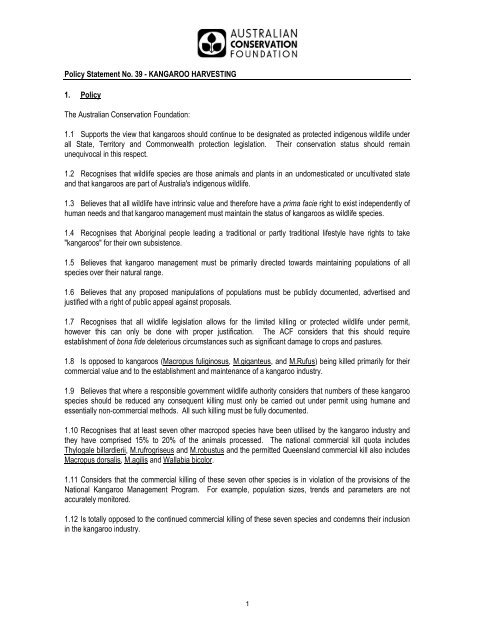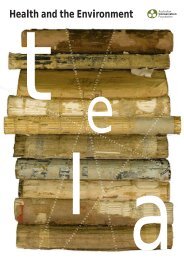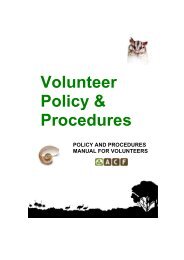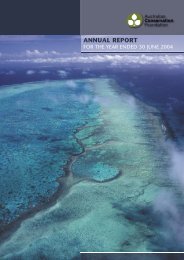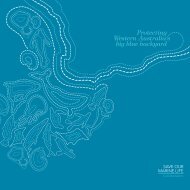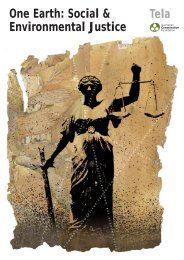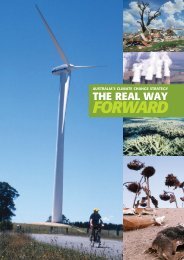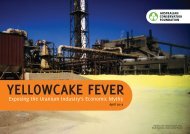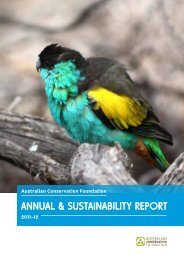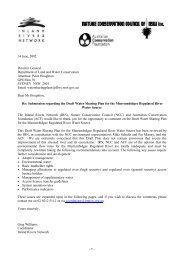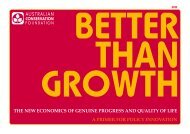Kangaroo Harvesting.pdf - Australian Conservation Foundation
Kangaroo Harvesting.pdf - Australian Conservation Foundation
Kangaroo Harvesting.pdf - Australian Conservation Foundation
- No tags were found...
You also want an ePaper? Increase the reach of your titles
YUMPU automatically turns print PDFs into web optimized ePapers that Google loves.
2. Supporting statement2.1 PhilosophyWildlife populations have rights of their own to exist and flourish independently of human needs. <strong>Kangaroo</strong>s andother wildlife species should not be regarded merely as a human resource and commercial exploitation shouldnever be contemplated. Internationally the widespread protests against sealing and whaling and the growingprotests against the commercial slaughter of kangaroos show this is a widely held belief.2.2 <strong>Kangaroo</strong> PopulationsThe total kangaroo population size has dominated debate on the kangaroo issue. <strong>Australian</strong> authorities claimeda total population of 32-35 million in 1980, implied this had grown to 36 million in 1982, and even suggested itcould be as high as 60 million in 1983.In June 1983 a comprehensive estimate for the years 1980 to 1982 revealed the kangaroo population "peaked"in 1981 at only 19 million. (Gregg, Caughley and Short 1983)The 1982/83 drought was the most severe on record in eastern Australia and caused an overall mortality of 43%in inland New South Wales kangaroo populations. Applying the known mortality rates to relevant areas ofQueensland, NSW, Victoria and South Australia reveals that the post-drought kangaroo population would notexceed 13 million. Australia's human population exceeded 15 million in 1983. The post-drought floods inwestern Queensland and north west NSW caused additional heavy post-drought kangaroo mortalities.2.3 <strong>Kangaroo</strong>s and Rural IndustriesAustralia is heavily dependent on primary products and rural interests are consequently very powerful politically.Since the introduction of agriculture into Australia at the time of European settlement, primary producers haveregarded kangaroos as pests; they are said to damage crops, destroy fences, foul waterholes and eat outpastures.Despite the antiquity and extent of these claims, no real attempt has been made to investigate them objectivelyand comprehensively. Up to the present time, Australia's State and Federal Governments have found itconvenient to uncritically accept such claims at face value.For these reasons, our wildlife authorities have not been able to withstand the constant pressures from ruralareas for permission to destroy large numbers of kangaroos which are otherwise afforded the status of protectedwildlife throughout Australia.The kangaroo industry has been allowed to develop and flourish by these authorities under the guise of a"management tool" to facilitate, legitimise and nationalise the large scale killing of kangaroos.2.4 Competition with Domestic StockAlthough kangaroos are alleged to benefit from agricultural land-use, they are actually directly threatened byintensive agriculture (cropland and improved pasture) which occupies 6% of the continent.Commercial shooting of kangaroos is claimed to be essential to control kangaroo pests on the low intensitygrazing lands (sheep pastoral zone and cattle extensive zone) which occupy about 59% of the continent. Sincethe early to mid 1970s Australia's livestock numbers have fallen by 25% and the largest losses have been in thelow intensity grazing lands.2
The low intensity grazing lands are predominantly native vegetation and there are no extensive studies whichprove stock and kangaroos compete heavily for food in the these areas. On the contrary, many studies havesuggested that competition is limited.Despite the critical importance of this issue, major reviewers of kangaroo biology have stated that lack ofinformation on the stock-kangaroo grazing interaction .... is probably the most serious gap in our knowledge ofkangaroo ecology". (Russell, 1974, Cunningham, 1981)2.5 Extent of Commercial KillingBetween 1981 and 1983 the annual <strong>Australian</strong> commercial kangaroo kill quota has exceeded 3 million and atleast 1.5 to 2.5 million kangaroos have been processed commercially each year.These figures have made the kangaroo industry the world's largest commercial slaughter of wildlife (apart fromcommercial fishing) and for this reason opposition to the kangaroo industry has grown rapidly both nationally andinternationally.The 1975 to 1983 State and National kangaroo kill quotas were arbitrary figures which bore no direct relationshipto actual population sizes, environmental conditions, legal killing rates or the size of the commercial kill.Between 1975 and 1981 quotas grew by 240% from 885,000 to over 3 million yet over the same period totaldomestic livestock numbers fell by 25%.The total value of kangaroo products rose from $2 million in 1975 to $19 million in 1981 and the average value ofeach kangaroo processed rose from $4.00 to $12.00 over the same period. Thus the commercial incentive to killkangaroos grew rapidly. (Rawlinson, 1983)2.6 The Consequences of Commercial KillingCommercial shooting of kangaroos is highly selective with an extreme male bias (80%) and a bias towards theolder age classes. This selectively results from the greater commercial attractiveness of the larger kangaroosand the fact that there is a pronounced sexual dimorphism in the three species with males being much largerthan females of the same age.Where the species overlap, there is also a bias towards Red kangaroos. Thus commercial shooting is selectiveand causes substantial population changes.Overall population monitoring is by large scale aerial survey, no information is collected on sex ratios or ageclasses except indirectly.There are no realistic population models for the three species, thus the consequences of the extreme male andage bias in commercial shooting are unknown.In commercial kangaroo shooting, the proportion of mature females increases and reproductive potential shouldalso rise, so a priori reasoning indicates population growth would ultimately result unless shooting pressureswere excessive.If the value of kangaroos continued to rise and demand also continued to increase, shooters would exploit morefemales. As females are much smaller than males, larger numbers would be needed to supply a set amount ofmeat, leather, etc. Once mature females are being heavily exploited, kangaroo populations will be directlythreatened.3
2.7 Legislative Basis for Commercial KillingAll wildlife legislation allows for the limited killing of protected wildlife under permit or open seasons. However,this can only be done with proper justification.Australia has no legitimate legal National management program for kangaroo species under the <strong>Australian</strong>National Parks and Wildlife Act 1975 or the Wildlife Protection (Regulation of Exports and Imports) Act 1982. Noprograms have been formulated, approved or implemented for the kangaroo species under the relevant sectionsof these Acts.All State, Territory and Commonwealth fauna protection legislation affords kangaroos the status of protectedwildlife. Despite this the extensive kangaroo industry has developed, facilitated either by the declaration of openseasons (Queensland and Tasmania) or through the misuse of provisions of Acts designed to allow thedestruction of wildlife causing agricultural damage (NSW, SA, WA and Victoria until 1983).There is no specific Commonwealth, State or Territory Act to control or administer the kangaroo industry. Inaddition the various legislated State and Territory fauna protection Acts contain no specific clauses enables theestablishment or maintenance of a kangaroo industry.No <strong>Australian</strong> Parliament has debated the establishment of the kangaroo industry nor passed any legislationspecifically intended to establish such an industry, therefore it has been set up without genuine publicdiscussion.There is no legal or democratic mandate for a kangaroo industry.3. ReferencesCAUGHLEY, GRIGG AND SHORT (1983) "How Many <strong>Kangaroo</strong>s?" Search 14: 151-154CUNNINGHAM, D.K. (1981)"Arid-zone <strong>Kangaroo</strong>s - Pest or Resource?" Chapter 8 In Kitching, R.I. and R.F.Jones (Eds) The Ecology of Pests: Some <strong>Australian</strong> Case Studies CSIRO, Melbourne: 19-52RAWLINSON, P.A. (1983) "Questions Regarding the Legality and Morality of the <strong>Kangaroo</strong> Industry" <strong>Kangaroo</strong>Management - Proceedings of a Public Forum, Adelaide 28 June 1983. SA National Parks and Wildlife Service,Adelaide, 65-113.Adopted March 19844


